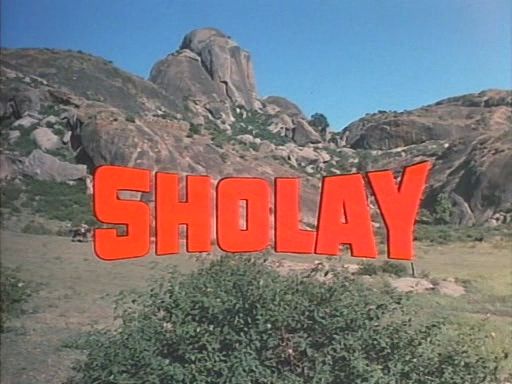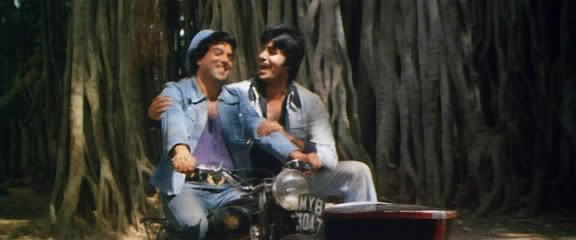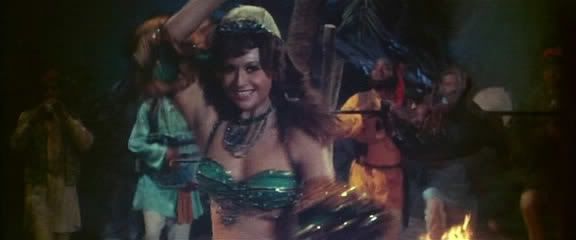
Tonight I am startng to look at the movie Sholay. I saw it over 30 years ago and never did see it again.
I know it is one of the greatest movies put out during that era of Indian Cinema.
NB: Sorry Amral, had to use this:

Replies sorted oldest to newest
g'morningquote:Originally posted by Mitwah:
Yeh Dosti
Great song about friendship....Amitabh Bachan and Dharmendra...









quote:Originally posted by asj:
I love doing this:
.


quote:Originally posted by Riya:quote:Originally posted by asj:
I love doing this:
.
oh, we can tellAnd we so enjoy you doing this

my favouriteeeeeeeeeeeeequote:Originally posted by asj:
.

quote:Originally posted by IK:my favouriteeeeeeeeeeeeequote:Originally posted by asj:
.tnks ASJ for doing all this, i am so going to enjoy this......

quote:Originally posted by asj:
.
quote:Originally posted by asj:quote:Originally posted by IK:my favouriteeeeeeeeeeeeequote:Originally posted by asj:
.tnks ASJ for doing all this, i am so going to enjoy this......

I think the song was "Hey Dosti" IK, It is slowly bringing back the memories.
.








this was one big song back in those days, the 2 of them was excellent n how i had loved them....quote:Originally posted by asj:quote:Originally posted by IK:my favouriteeeeeeeeeeeeequote:Originally posted by asj:
.tnks ASJ for doing all this, i am so going to enjoy this......

I think the song was "Hey Dosti" IK, It is slowly bringing back the memories.
.
i had felt so sorry for him without his arms.quote:Originally posted by asj:
.
this was so funnyyyy..quote:Originally posted by asj:
.
did she ever prattle......but she's lovelyquote:Originally posted by asj:
.
this was the looks that made him a hearthrob then.....quote:Originally posted by asj:
.
quote:Originally posted by IK:
ASJ, wonderful job, remember the two headed coin that Amit had????????
i don't need to watch the movie, i am seeing it here.....just kidding but tnks for doing this, g'night.

quote:so finally i am going to see what all the hype is about
quote:Originally posted by asj:
Sholay 1975

Staring: Dharmendra, Amithabh Bachchan, Hema Malini, Jaya Bhaduri, Sanjeev Kumar and Amjad Khan
Director: Ramesh Sippy
Producer: G. P. Sippy
Music: R. D. Burman
Running time: 198 minutes (DEI/Eros), 204 (Eros/B4U)
Format: NTSC
Video: 1.85:1 non-anamorphic widescreen (DEI/Eros), 4:3 full screen (Eros/B4U)
Sound: Hindi Dolby Digital Surround
Subtitles: English
Year: 1975 (cinema), 1999 (DVD)
DVD: Single sided dual layered
DVD Author: Digital Entertainment Inc (DEI/Eros), Dot Media (Eros/B4U)
DVD Release by: Eros International
.



quote:Originally posted by asj:
Sholay 1975
'Sholay's dialogue has now become colloquial language, part of the way a nation speaks to itself. Single lines, even phrases, taken out of context, can communicate a whole range of meaning and emotion. In canteens across the country, collegians still echo Gabbar when they notice a budding romance: 'Bahut yaarana hai.' The lines come easily to the lips of Indians: 'Jo dar gaya, samjho mar gaya', 'Ai chhammia', 'Arre o Sambha', Kitne aadmi the?', 'Hum angrezon ke zamaane ke jailer hain'.
'Kitne aadmi the?' What kind of man you are?
Very popular dialogue:
.
quote:Originally posted by asj:
One of the three songs is watchable, the other two appears like the video is not there anymore.
quote:The fee was Rs 100 per retake. On a good day, the light boys returned from the day's shooting richer by Rs 2,000.







remember when he threw broken pieces of bottle for her to dance on, she did and the bottom of her feet were cut n the blood flowing? That was so sad......I had felt so sorry for her and hated Gabbar.quote:
the looks that made him the heartthrob of the 70/80's .......quote:Originally posted by asj:
BIG B AS HE LOOKED 34 YEARS AGO IN SHOLAY:
.
quote:Originally posted by asj:
Sholay 1975
Almost as time-consuming were the sequences of Radha extinguishing the lamps while Jai played his harmonica and watched. These sequences establish the gradual, wordless bonding between the widow and the thief - the sympathy and admiration slowly turning into love. Capturing the right mood was critical. These were two sequences, only about a minute each in the final film, and it took twenty days to shoot them. Ramesh and Divecha decided to do the scenes in 'magic hour', a cinema term for the time between sunset and night. The light that falls during magic hour is dreamlike in its warm golden hue. The director and cinemtograher wanted specifically the velvety dusk which arrives at the tail end of the golden hue. A shadowy darkness precedes nightfall, but it is still light enough to show the surrounding silhouettes. Essentially, they had only a few minutes to capture the shot. The preparations for the shot would begin after lunch. The lights and the camera set-up would be in place well before time. At around five in the evening they would rehearse the shot and the camera movements.Then between six and six-thirty as the sun started to set, there was total pandemonium. Everyone ran around shouting, trying to get the shot before darkness. sometimes they would get one shot, sometimes two and very rarely with great difficulty, a third re-take. But there was never any time to change the set-up. Ramesh wouldn't settle for anything less than perfection. Invariably there was always some mess-up. The sun set earlier than expected, a light man made a mistake, the trolly movement wasn't right, some object was lying where it shouldn't have been. There were times when Jaya lost her cool: 'Ramesh, no one can see me,' she would say. 'It's a long shot, no viewer on the planet is going to be able to see the mistakes in continuity.' The answer always was: 'No, no, one more take.' Ramesh dressed each frame. The Lady-of-the-lamps shot became a kind of a joke. It took several schedules to get it right.
In fact, in terms of time taken, each sequence seemed to compete with the next. Ahmed, the blind Imam's son (played by Sachin), for instance, took seventeen days to die. It was a long and complicated sequence, and originally it also included the actual act of killing: meat is roasting in the foreground; Gabbar points a red-hot skewer at the boy and with a gleeful look tells his gang, 'Isko to bahut tadpa tadpa ke maroonga.' But this never made it to the final cut. Instead, the scene cuts from Gabbar killing an ant to Ahmed's horse carrying his dead body into the village.
.
quote:Originally posted by IK:
the looks that made him the heartthrob of the 70/80's .......
quote:Now he look ridiculous with the black hair and grey beard.
quote:Originally posted by asj:
Whats up bro, long time.



wow, what an all consuming love n the tragic ending....so sad, he was so masterful in that rolequote:Originally posted by asj:
Sholay 1975
PERSONALITIES BEHIND SHOLAY 1975:
Sanjeev Kumar as he appears in Sholay
Hari bhai died in 1985. He was only forty-seven,but a lifetime of unhealthy eating and drinking habits had caught up with him. Sanjeev never achieved the status of 'phenomenon' as Rajesh Khanna or Amitabh Bachchan did. In fact, toward the end, he had become increasingly careless about his looks. But his name was a standard for good acting. And unlike other stars, he wasn't bound by commercial considerations. He enthusiatically donned a gray wig to play the Thakur. For Sanjeev, always, the role was the prize.
N.B. May I add here that Sanjeev was one of the men who was very much in love with Hema Malini, it is rumored that to appease that love which was rebuffed, he resort to the bottle and eventually that was partly the cause for his demise:
.
quote:Originally posted by asj:
DID HE LOVED HEMA SO MUCH THAT HE DRANK HIMSELF TO DEATH?
.

















quote:Originally posted by IK:
ASJ, so much to read my head is spinning
i've only skimmmed it a bit, will read when i have some more time, lots of interesting stuff
now to the pics they're glorious even the one where Amit died, i still remember that one n how i had cried when i saw it....


Access to this requires a premium membership.